Performance Evaluation of Plastic Concrete Modified with E-Waste Plastic as a Partial Replacement of Coarse Aggregate
Abstract
:1. Introduction
2. Materials and Methods
2.1. Materials
2.2. Manufacturing Procedure of E-Waste PCA
2.3. Concrete Mix Proportions
2.4. Test Methods
3. Results and Discussion
3.1. Workability
3.2. Fresh and Dry Density
3.3. Mechanical Properties
3.3.1. Compressive Strength
3.3.2. Splitting Tensile Strength
3.3.3. Flexural Strength Test
3.4. Durability Properties
3.4.1. Abrasion Resistance
3.4.2. Alternate Wetting and Drying
3.4.3. Sorptivity Coefficient
3.4.4. Ultrasonic Pulse Velocity (UPV)
4. Conclusions
- The incorporation of PCA in concrete significantly increased the workability (16.4–141% for 10% to 50% replacement ratios) due to the zero-water absorption of plastic aggregate. Moreover, the incorporation of PCA in concrete decreased the fresh and dry density of concrete composites for a maximum of 13.6% and 18.2%, respectively, reported at the 50% replacement level of NCA with PCA.
- The CS, STS and FS of RPAC were considerably reduced by increasing the percentage of PCA. The maximum percentage reduction in CS, STS and FS was achieved as 52.7%, 47.5% and 39.4%, respectively, for 50% replacement.
- The appreciable reduction (41.7%) in sorptivity value was observed for the maximum replacement of PCA considered in the study. The UPV values also remained within the required range of quality concrete after incorporating the full replacement of PCA. This suggests enhanced durability against the penetration of chemicals into the concrete.
- The incorporation of PCA in concrete improved the concrete abrasion resistance. Abrasion resistance increased in the range of 32–51% for different substitution ratios. This can be ascribed to the higher abrasion resistance and toughness of plastic aggregate with respect to natural aggregate. Moreover, loss in CS was also reduced after exposure to alternate wetting and drying cycles with respect to the control mix.
- The manufactured E-waste plastic aggregate can be used to substitute NCA in concrete by volume (10–50%); however, 30% substitution is recommended because up to this level, the characteristic strength of M25 concrete was obtained. Furthermore, the substitution level of 40% and 50% is recommended to be utilized in nonstructural lightweight elements. Additionally, the use of plastic aggregate is recommended to be used in marine conditions owing to its non-absorption capacity, which resists the ingress of hazardous chemicals such as chloride and sulphate, etc. The conventional steel and fiber-reinforced polymer (FRP) rebars in PCA-incorporated concrete are expected to perform better under an alkaline environment; however, more insights regarding the durability of FRPs in PCA-incorporated concrete shall be investigated first from the relevant literature [59,60]. In addition, machine learning techniques are widely used for investigating material properties [61,62,63,64,65,66,67] and general engineering problems [68,69]. Therefore, for the PCA-incorporated concrete, a machine learning regression model can be developed to accurately forecast the strength and durability characteristics for variable input parameters. Future studies need to explore other properties of RPAC, alone or in combination with reinforcing agents such as nanomaterials or fibers, to investigate the mechanical and durability properties, including salt scaling, carbonation, freeze–thaw cycles, concrete to steel bond properties, fire resistance of RPAC, etc.
Author Contributions
Funding
Institutional Review Board Statement
Informed Consent Statement
Data Availability Statement
Acknowledgments
Conflicts of Interest
References
- Iqbal, M.; Zhao, Q.; Zhang, D.; Jalal, F.E.; Jamal, A. Evaluation of tensile strength degradation of GFRP rebars in harsh alkaline conditions using non-linear genetic-based models. Mater. Struct. 2021, 54, 1–20. [Google Scholar] [CrossRef]
- Ali, K.; Qureshi, M.I.; Saleem, S.; Khan, S.U. Effect of waste electronic plastic and silica fume on mechanical properties and thermal performance of concrete. Constr. Build. Mater. 2021, 285, 122952. [Google Scholar] [CrossRef]
- Vashisht, R.; Shukla, A. Potential application of bacteria to improve the self-healing and strength of concrete. J. Build. Pathol. Rehabil. 2020, 5, 1–13. [Google Scholar] [CrossRef]
- Ahmad, F. Influence of nano graphite platelets on the behavior of concrete with E-waste plastic coarse aggregates. Constr. Build. Mater. 2021, 316, 125980. [Google Scholar] [CrossRef]
- Santarsiero, G.; Masi, A.; Picciano, V. Durability of Gerber Saddles in RC Bridges: Analyses and Applications (Musmeci Bridge, Italy). Infrastructures 2021, 6, 25. [Google Scholar] [CrossRef]
- Gasperi, J.; Wright, S.L.; Dris, R.; Collard, F.; Mandin, C.; Guerrouache, M.; Langlois, V.; Kelly, F.J.; Tassin, B. Microplastics in air: Are we breathing it in? Curr. Opin. Environ. Sci. Health. 2018, 1, 1–5. [Google Scholar] [CrossRef] [Green Version]
- Saikia, N.; De Brito, J. Use of plastic waste as aggregate in cement mortar and concrete preparation: A review. Constr. Build. Mater. 2012, 34, 385–401. [Google Scholar] [CrossRef]
- Suchithra, S.; Kumar, M.; Indu, V. Study on replacement of coarse aggregate by E-waste in concrete. Int. J. Tech. Res. Appl. 2015, 3, 266–270. [Google Scholar]
- Paul, S.C.; Šavija, B.; Babafemi, A.J. A comprehensive review on mechanical and durability properties of cement-based materials containing waste recycled glass. J. Clean. Prod. 2018, 198, 891–906. [Google Scholar] [CrossRef]
- Ragaert, K.; Delva, L.; Van Geem, K. Mechanical and chemical recycling of solid plastic waste. Waste Manag. 2017, 69, 24–58. [Google Scholar] [CrossRef] [PubMed]
- Alagusankareswari, K.; Kumar, S.S.; Vignesh, K.; Niyas, K.A.H. An experimental study on e-waste concrete. Indian J. Sci. Technol. 2016, 9. [Google Scholar] [CrossRef]
- Manikandan, M.; Arul Prakash, D.; Manikandan, P. Experimental Study On E–Waste Concrete And Comparing With Conventional Concrete. Jr. Ind. Pollut. Control 2017, 33, 1490–1495. [Google Scholar]
- Manjunath, B.A. Partial replacement of e-plastic waste as coarse-aggregate in concrete. Procedia Environ. Sci. 2016, 35, 731–739. [Google Scholar] [CrossRef]
- Prasanna, P.K.; Rao, M.K. Strength variations in concrete by using E-waste as coarse aggregate. J. Educ. Appl. Res. 2014, 4. Available online: http://ijear.org/vol4/spl2/ec0046.pdf (accessed on 23 November 2021).
- Rumpf, H. The characteristics of systems and their changes of state disperse. In Particle Technology, Chapman and Hall; Springer: Berlin/Heidelberg, Germany, 1990; pp. 8–54. [Google Scholar]
- Ali, B.; Qureshi, L.A.; Shah, S.H.A.; Rehman, S.U.; Hussain, I.; Iqbal, M. A step towards durable, ductile and sustainable concrete: Simultaneous incorporation of recycled aggregates, glass fiber and fly ash. Constr. Build. Mater. 2020, 251, 118980. [Google Scholar] [CrossRef]
- Kurad, R.; Silvestre, J.D.; de Brito, J.; Ahmed, H. Effect of incorporation of high volume of recycled concrete aggregates and fly ash on the strength and global warming potential of concrete. J. Clean. Prod. 2017, 166, 485–502. [Google Scholar] [CrossRef]
- Bahij, S.; Omary, S.; Feugeas, F.; Faqiri, A. Fresh and hardened properties of concrete containing different forms of plastic waste–A review. Waste Manag. 2020, 113, 157–175. [Google Scholar] [CrossRef]
- Tamanna, N.; Tuladhar, R.; Sivakugan, N. Performance of recycled waste glass sand as partial replacement of sand in concrete. Constr. Build. Mater. 2020, 239, 117804. [Google Scholar] [CrossRef]
- Ahmad, F. Optimum values for mixing ratio and tire shred size of sand tire mix. In Proceedings of the 1st Conference on Sustainability in Civil Engineering, CUST, Islamabad, Pakistan, 1 August 2019. [Google Scholar]
- Ahmad, A.; Adil, M.; Khalil, A.; Rahman, M. Mechanical properties and durability of boardcrete blocks prepared from recycled cardboard. J. Build. Eng. 2021, 33, 101644. [Google Scholar] [CrossRef]
- De la Colina Martínez, A.L.; Barrera, G.M.; Díaz, C.E.B.; Córdoba, L.I.Á.; Núñez, F.U.; Hernández, D.J.D. Recycled polycarbonate from electronic waste and its use in concrete: Effect of irradiation. Constr. Build. Mater. 2019, 201, 778–785. [Google Scholar] [CrossRef]
- Barnes, D.K.; Galgani, F.; Thompson, R.C.; Barlaz, M. Accumulation and fragmentation of plastic debris in global environments. Philos. Trans. R. Soc. B Biol. Sci. 2009, 364, 1985–1998. [Google Scholar] [CrossRef] [Green Version]
- Pramila, S.; Fulekar, M.; Bhawana, P. E-waste-A challenge for tomorrow. R Res. J. Recent Sci. ISSN. 2012, 2277, 2502. [Google Scholar]
- Colangelo, F.; Cioffi, R.; Liguori, B.; Iucolano, F. Recycled polyolefins waste as aggregates for lightweight concrete. Compos. Part B Eng. 2016, 106, 234–241. [Google Scholar] [CrossRef]
- Akçaözoğlu, S.; Atiş, C.D.; Akçaözoğlu, K. An investigation on the use of shredded waste PET bottles as aggregate in lightweight concrete. Waste Manag. 2010, 30, 285–290. [Google Scholar] [CrossRef]
- Shinu, N.M.T.; Needhidasan, S. An experimental study of replacing conventional coarse aggregate with E-waste plastic for M40 grade concrete using river sand. Mater. Today Proc. 2020, 22, 633–638. [Google Scholar] [CrossRef]
- Sabău, M.; Vargas, J. Use of e-plastic waste in concrete as a partial replacement of coarse mineral aggregate. Comput. Concr. 2018, 21, 377–384. [Google Scholar] [CrossRef]
- Tafheem, Z.; Rakib, R.I.; Esharuhullah, M.; Alam, S.R.; Islam, M.M. Experimental investigation on the properties of concrete containing post-consumer plastic waste as coarse aggregate replacement. J. Mater. Eng. Struct. 2018, 5, 23–31. [Google Scholar]
- Kumar, K.S.; Baskar, K. Recycling of E-plastic waste as a construction material in developing countries. J. Mater. Cycles Waste Manag. 2015, 17, 718–724. [Google Scholar] [CrossRef]
- Rathore, V.; Rawat, A. Effective utilization of electronic waste in concrete mixture as a partial replacement to coarse aggregates. In Proceedings of the International Conference on Sustainable Materials and Structures for Civil Infrastructures (SMSCI2019), Bhopal, India, 25 September 2019; AIP Publishing LLC: Melville, NY, USA; Volume 2158, p. 020037. [Google Scholar]
- Ullah, Z.; Qureshi, M.I.; Ahmad, A.; Khan, S.U.; Javaid, M.F. An experimental study on the mechanical and durability properties assessment of E-waste concrete. J. Build. Eng. 2021, 38, 102177. [Google Scholar] [CrossRef]
- Nadhim, S.; Shree, P.N.; Kumar, G.P. A Comparative Study On Concrete Containing E-Plastic Waste And Fly Ash Concrete With Conventional Concrete. J. Sci. Technol. 2016. Available online: http://gist.edu.in/gist/wp-content/uploads/2019/03/Parishodhana-2018-1.pdf#page=31 (accessed on 23 November 2021).
- Akram, A.; Sasidhar, C.; Pasha, K.M. E-waste management by utilization of E-plastics in concrete mixture as coarse aggregate replacement. Int. J. Innov. Res. Sci. Eng. Technol. 2015, 4. Available online: http://www.ijirset.com/upload/2015/july/8_E-Waste.pdf (accessed on 23 November 2021).
- Lakshmi, R.; Nagan, S. Investigations on durability characteristics of E-plastic waste incorporated concrete. Asian J. Civ. Eng. (Build. Hous.) 2011, 12, 773–787. [Google Scholar]
- Lakshmi, R.; Nagan, S. Utilization of waste E plastic particles in cementitious mixtures. J. Struct. Eng. 2011, 38, 26–35. [Google Scholar]
- Gourmelon, G. Global plastic production rises, recycling lags. Vital Signs 2015, 22, 91–95. [Google Scholar]
- Ferreira, L.; de Brito, J.; Saikia, N. Influence of curing conditions on the mechanical performance of concrete containing recycled plastic aggregate. Constr. Build. Mater. 2012, 36, 196–204. [Google Scholar] [CrossRef]
- ASTM C1602/C1602M-12; Standard Specification for Mixing Water Used in the Hydraulic Cement Concrete. ASTM International: West Conshohocken, PA, USA, 2012.
- ASTM C150; Standard Specification for Portland Cement. ASTM International: West Conshohocken, PA, USA, 1994.
- Rutkowski, J.V.; Levin, B.C. Acrylonitrile–butadiene–styrene copolymers (ABS): Pyrolysis and combustion products and their toxicity—a review of the literature. Fire Mater. 1986, 10, 93–105. [Google Scholar] [CrossRef] [Green Version]
- ASTM C143/143M-10a; Standard Test Method for Slump of Hydraulic-Cement Concrete. Annual Book of ASTM Standards, American Society for Testing and Materials (ASTM): West Conshohocken, PA, USA, 2010; p. 4.
- ASTM C138/C138M-17a; Standard Test Method for Density (Unit Weight), Yield, and Air Content (Gravimetric) of Concrete. ASTM International: West Conshohocken, PA, USA, 2017.
- ASTM C496/C496M (2011); Standard Test Method for Splitting Tensile Strength of Cylindrical Concrete Specimens. Annual Book of ASTM Standards, ASTM International: West Conshohocken, PA, USA, 2004.
- ASTM C39/C39M-12; Standard Test Method for Compressive Strength of Cylindrical Concrete Specimens. ASTM International: West Conshohocken, PA, USA, 2012.
- ASTM C78/C78M; Standard Test Method for Flexural Strength of Concrete (Using Simple Beam with Third-Point Loading). ASTM International: West Conshohocken, PA, USA, 2018. Available online: https://www.astm.org/c0078_c0078m-18.html (accessed on 23 November 2021).
- ASTM C1585-04; Standard Test Method for Measurement of Rate of Absorption of Water by Hydraulic-Cement Concretes. ASTM International: West Conshohocken, PA, USA, 2004.
- ASTM C131/C131-20; Standard Test Method for Resistance to Degradation of Small-Size Coarse Aggregate by Abrasion and Impact in the Los Angeles Machine. ASTM International: West Conshohocken, PA, USA, 2006. Available online: https://www.astm.org/c0131-06.html (accessed on 23 November 2021).
- Gjorv, O.E.; Shah, S. Testing methods for concrete durability. Matér. Constr. 1971, 4, 295–304. [Google Scholar] [CrossRef]
- Senthil Kumar, K.; Baskar, K. Response surfaces for fresh and hardened properties of concrete with e-waste (HIPS). J. Waste Manag. 2014, 2014. [Google Scholar] [CrossRef] [Green Version]
- Senhadji, Y.; Escadeillas, G.; Benosman, A.; Mouli, M.; Khelafi, H.; Ould Kaci, S. Effect of incorporating PVC waste as aggregate on the physical, mechanical, and chloride ion penetration behavior of concrete. J. Adhes. Sci. Technol. 2015, 29, 625–640. [Google Scholar] [CrossRef]
- Masi, A.; Digrisolo, A.; Santarsiero, G. Analysis of a large database of concrete core tests with emphasis on within-structure variability. Materials 2019, 12, 1985. [Google Scholar] [CrossRef] [Green Version]
- Ahirwar, S.; Malviya, P.; Patidar, V.; Singh, V.K. An experimental study on concrete by using E-waste as partial replacement for course aggregate. Int. J. Sci. Technol. Eng. 2016, 3, 7–13. [Google Scholar]
- Osei, D.Y. Experimental investigation on recycled plastics as aggregate in concrete. Int. J. Struct. Civ. Eng. Res. 2014, 3, 168–174. [Google Scholar]
- Ismail, Z.Z.; Al-Hashmi, E.A. Use of waste plastic in concrete mixture as aggregate replacement. Waste Manag. 2008, 28, 2041–2047. [Google Scholar] [CrossRef]
- Akinyele, J.; Ajede, A. The use of granulated plastic waste in structural concrete. Afr. J. Sci. Technol. Innov. Dev. 2018, 10, 169–175. [Google Scholar] [CrossRef]
- ASTM C131; Standard Test Method for Resistance to Degradation of Large-Size Coarse Aggregate by Abrasion and Impact in the Los Angeles Machine. ASTM International: West Conshohocken, PA, USA, 2012.
- Malhotra, V.M. Testing Hardened Concrete: Nondestructive Methods; Iowa State University Press: Iowa City, IA, USA, 1976; Available online: https://www.amazon.com/Testing-Hardened-Concrete-Nondestructive-Institute/dp/B000SAOCK6 (accessed on 23 November 2021).
- Iqbal, M.; Zhang, D.; Jalal, F.E. Durability evaluation of GFRP rebars in harsh alkaline environment using optimized tree-based random forest model. Waste Manag. 2009. [Google Scholar] [CrossRef]
- Iqbal, M.; Zhang, D.; Jalal, F.E.; Javed, M.F. Computational AI prediction models for residual tensile strength of GFRP bars aged in the alkaline concrete environment. Ocean. Eng. 2021, 232, 109134. [Google Scholar] [CrossRef]
- Trong, D.K.; Pham, B.T.; Jalal, F.E.; Iqbal, M.; Roussis, P.C.; Mamou, A.; Ferentinou, M.; Vu, D.Q.; Duc Dam, N.; Tran, Q.A. On Random Subspace Optimization-Based Hybrid Computing Models Predicting the California Bearing Ratio of Soils. Materials 2021, 14, 6516. [Google Scholar] [CrossRef] [PubMed]
- Onyelowe, K.C.; Jalal, F.E.; Iqbal, M.; Rehman, Z.U.; Ibe, K. Intelligent modeling of unconfined compressive strength (UCS) of hybrid cement-modified unsaturated soil with nanostructured quarry fines inclusion. Innov. Infrastruct. Solut. 2021, 7, 98. [Google Scholar] [CrossRef]
- Onyelowe, K.C.; Iqbal, M.; Jalal, F.E.; Onyia, M.E.; Onuoha, I.C. Application of 3-algorithm ANN programming to predict the strength performance of hydrated-lime activated rice husk ash treated soil. Multiscale Multidiscip. Model. Exp. Des. 2021, 1–16. [Google Scholar] [CrossRef]
- Jalal, F.E.; Xu, Y.; Li, X.; Jamhiri, B.; Iqbal, M. Fractal approach in expansive clay-based materials with special focus on compacted GMZ bentonite in nuclear waste disposal: A systematic review. Environ. Sci. Pollut. Res. 2021, 28, 43287–43314. [Google Scholar] [CrossRef]
- Jalal, F.E.; Xu, Y.; Iqbal, M.; Javed, M.F.; Jamhiri, B. Predictive modeling of swell-strength of expansive soils using artificial intelligence approaches: ANN, ANFIS and GEP. J. Environ. Manag. 2021, 289, 112420. [Google Scholar] [CrossRef] [PubMed]
- Jalal, F.E.; Xu, Y.; Iqbal, M.; Jamhiri, B.; Javed, M.F. Predicting the compaction characteristics of expansive soils using two genetic programming-based algorithms. Transp. Geotech. 2021, 30, 100608. [Google Scholar] [CrossRef]
- Iqbal, M.; Onyelowe, K.C.; Jalal, F.E. Smart computing models of California bearing ratio, unconfined compressive strength, and resistance value of activated ash-modified soft clay soil with adaptive neuro-fuzzy inference system and ensemble random forest regression techniques. Multiscale Multidiscip. Model. Exp. Des. 2021, 1–19. [Google Scholar] [CrossRef]
- Tran, T.-H.; Dam, N.D.; Jalal, F.E.; Al-Ansari, N.; Ho, L.S.; Phong, T.V.; Iqbal, M.; Le, H.V.; Nguyen, H.B.T.; Prakash, I.; et al. GIS-Based Soft Computing Models for Landslide Susceptibility Mapping: A Case Study of Pithoragarh District, Uttarakhand State, India. Math. Probl. Eng. 2021, 2021, 9914650. [Google Scholar] [CrossRef]
- Jamal, A.; Al-Ahmadi, H.M.; Butt, F.M.; Iqbal, M.; Almoshaogeh, M.; Ali, S. Metaheuristics for Traffic Control and Optimization: Current Challenges and Prospects; Intechopen: London, UK, 2021. [Google Scholar]

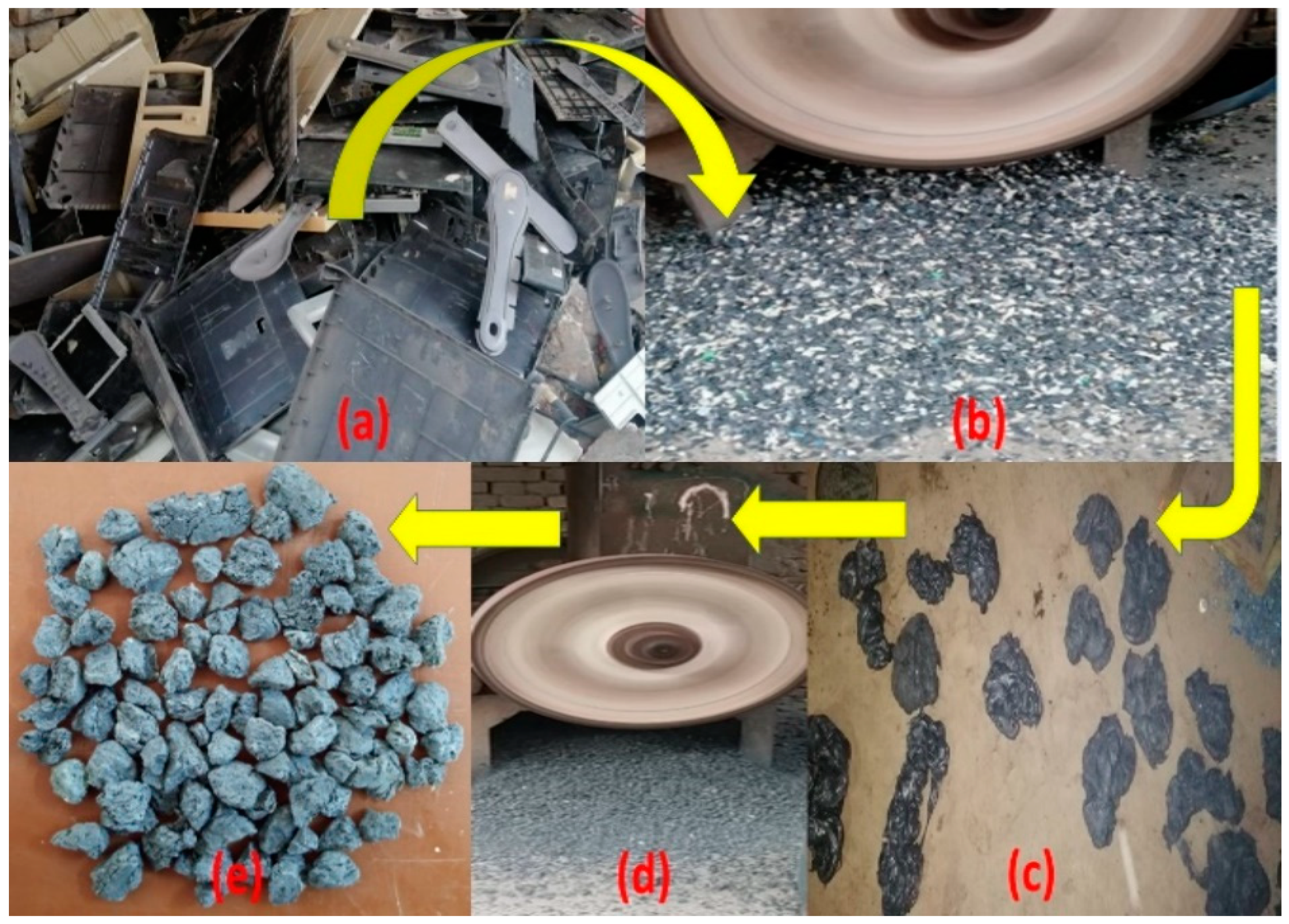



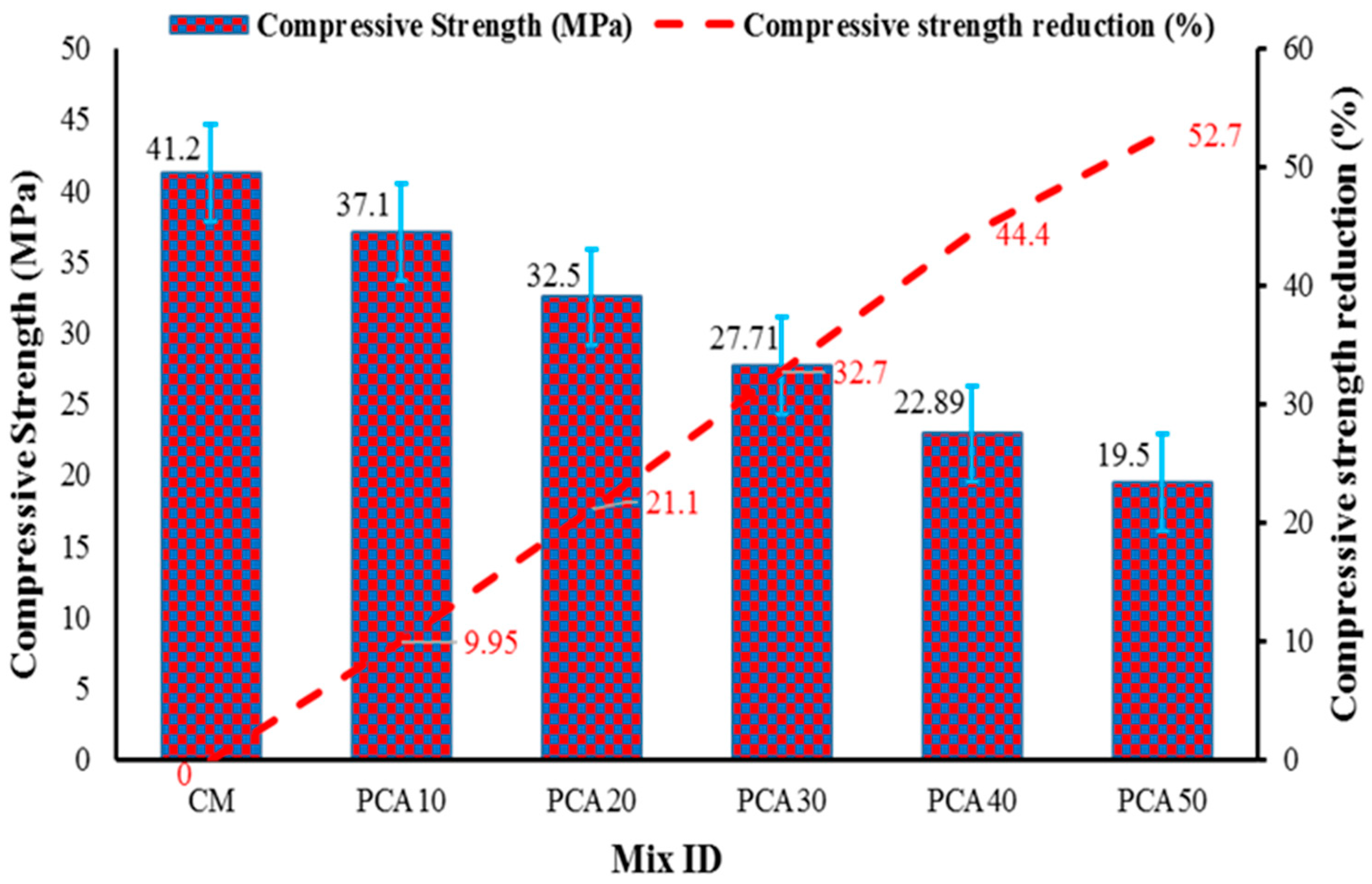
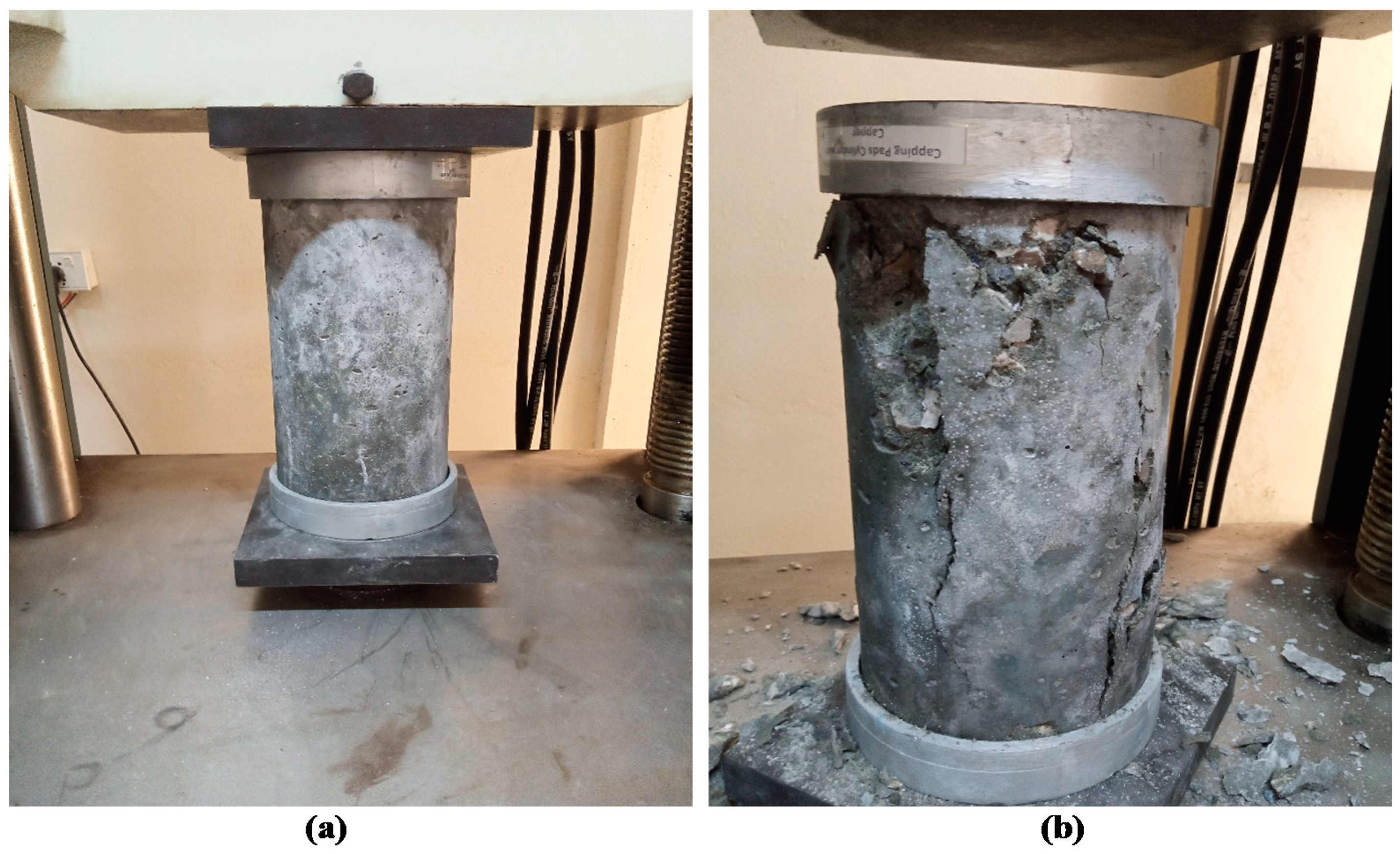
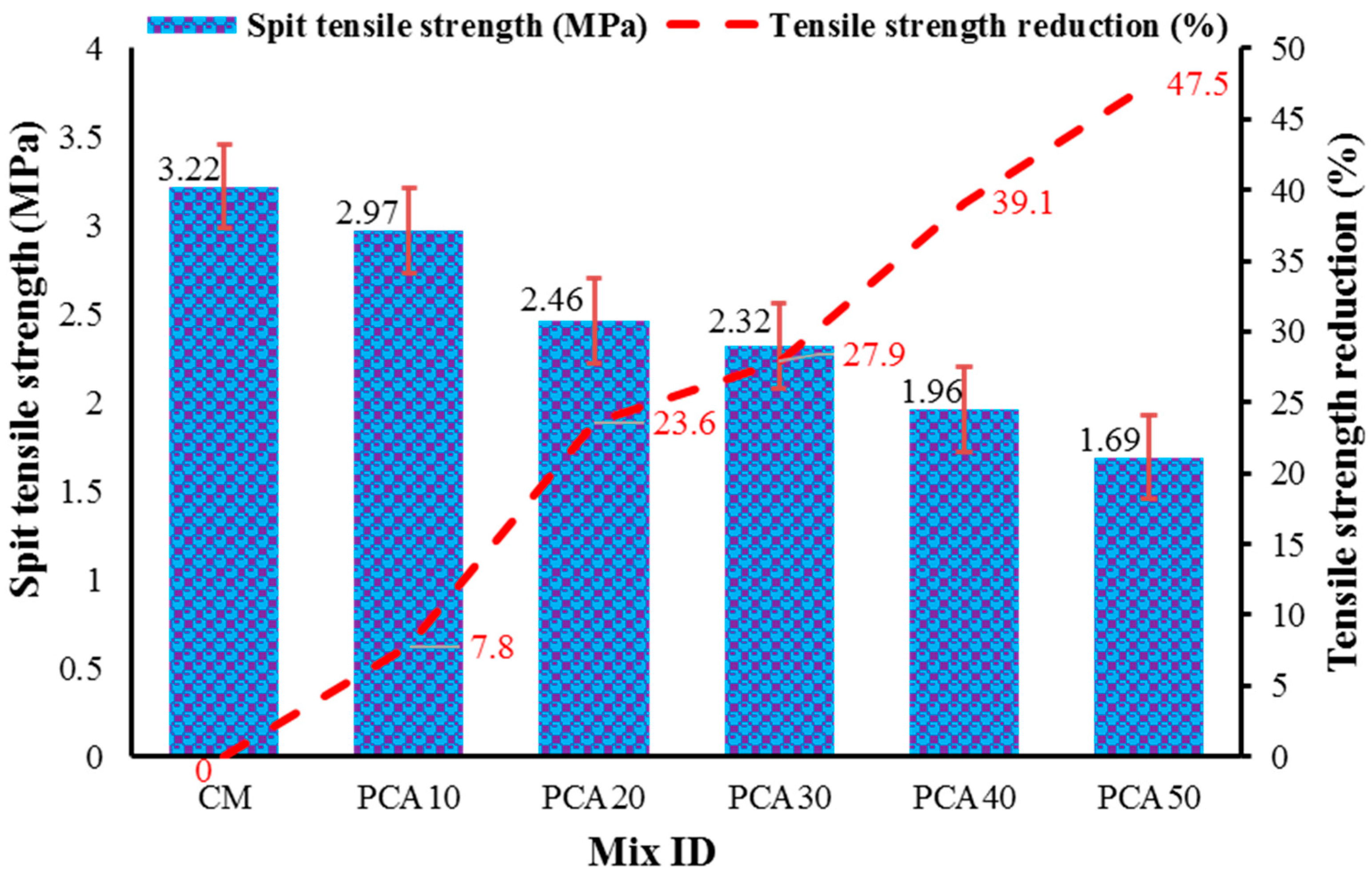
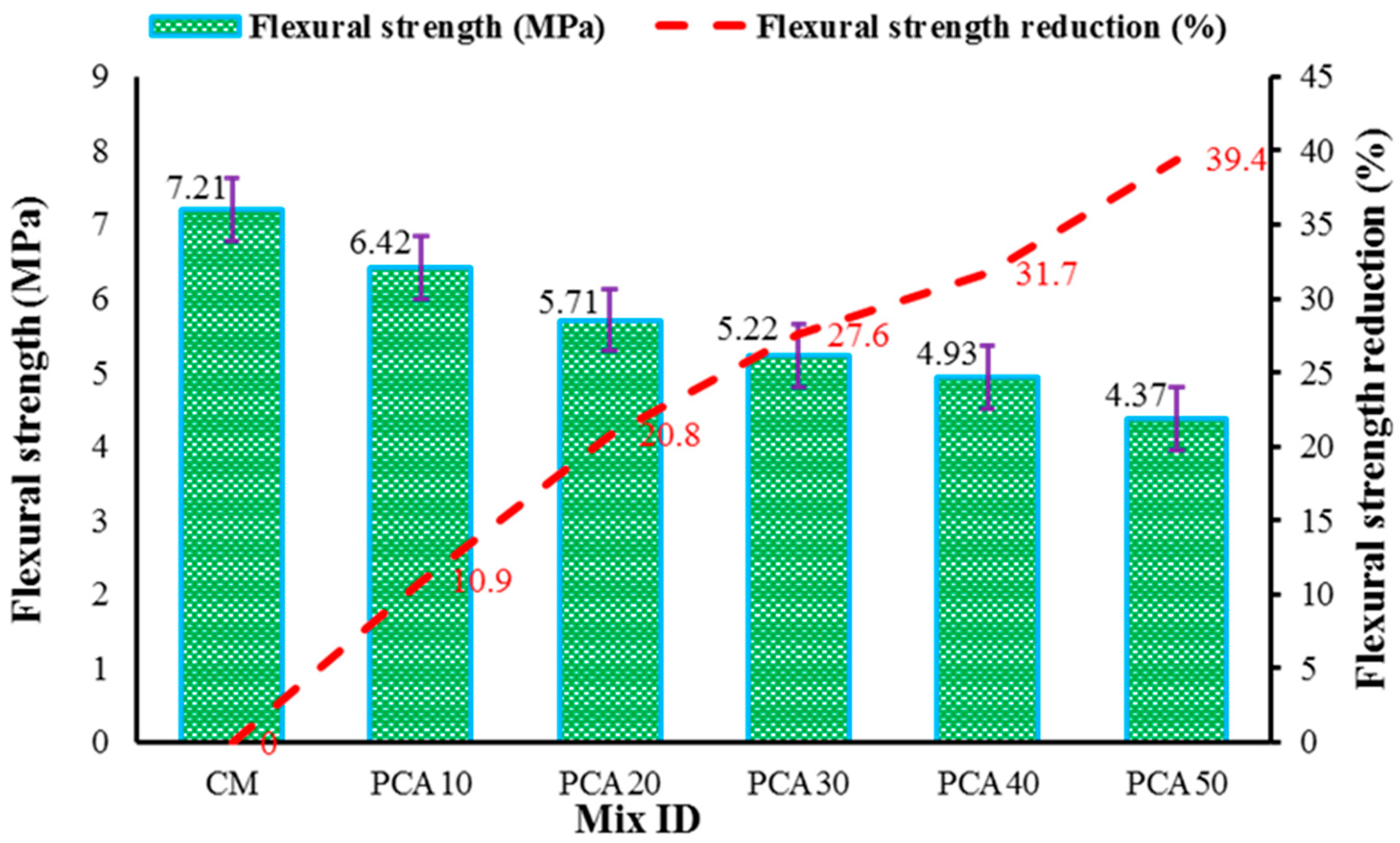
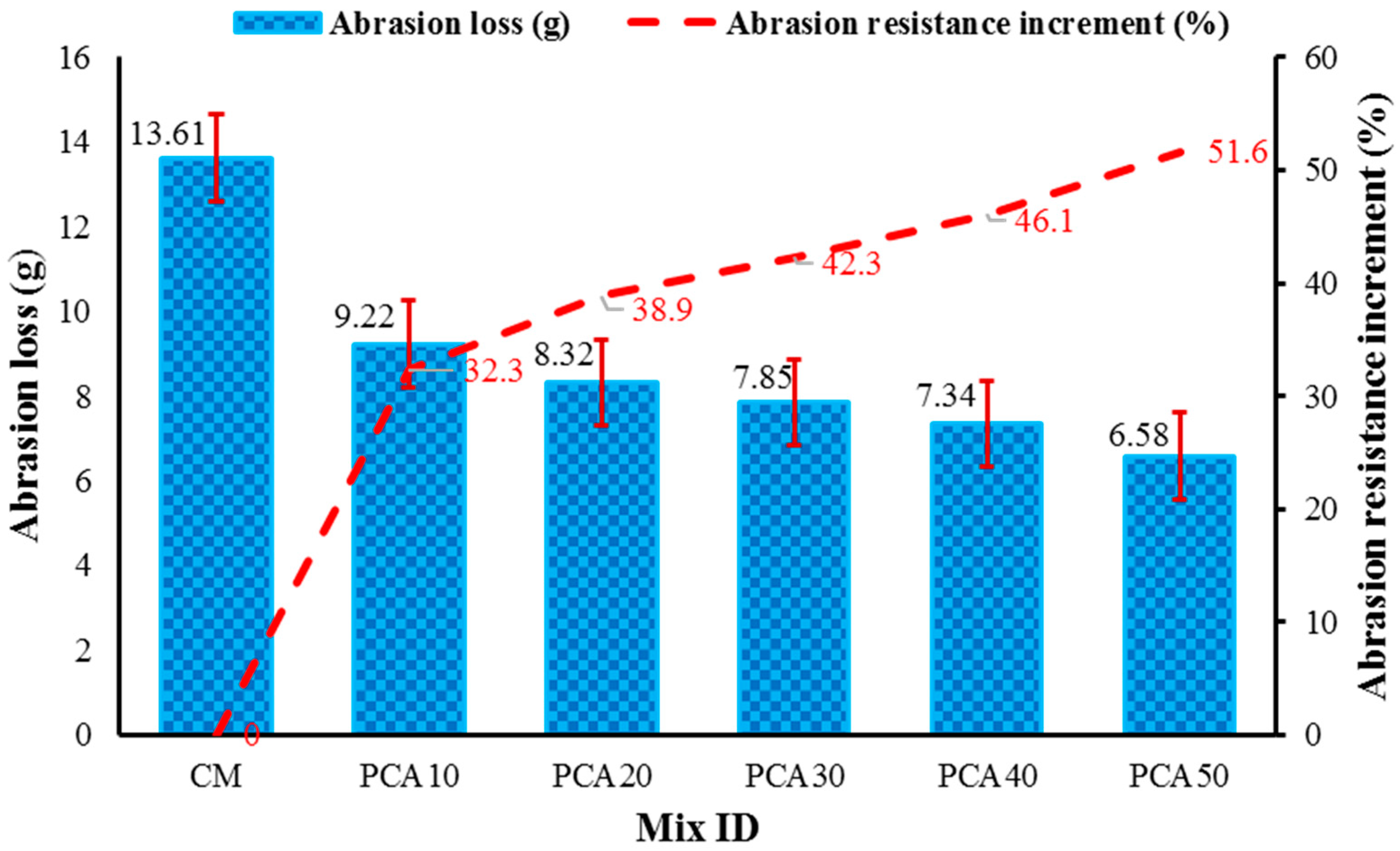
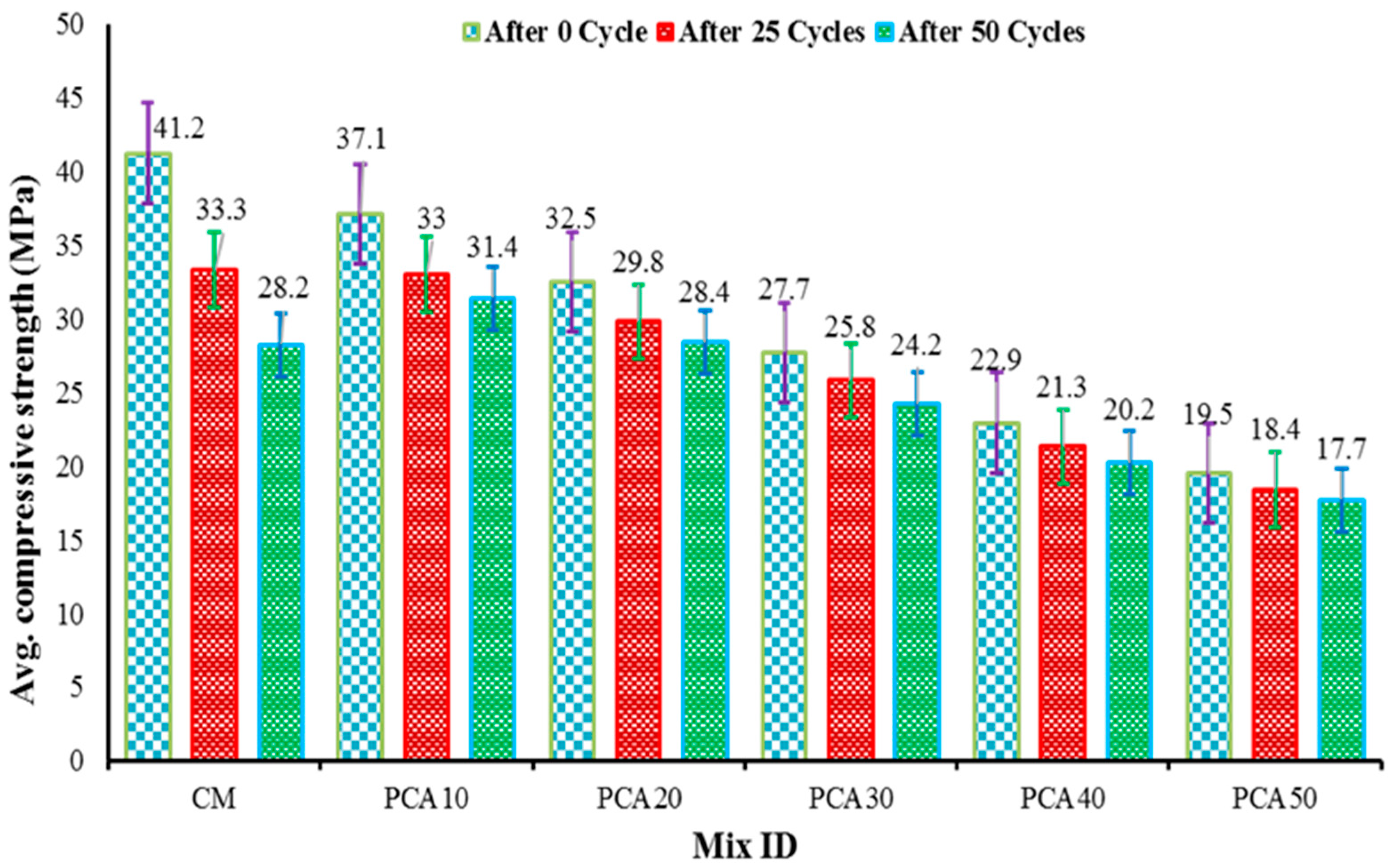

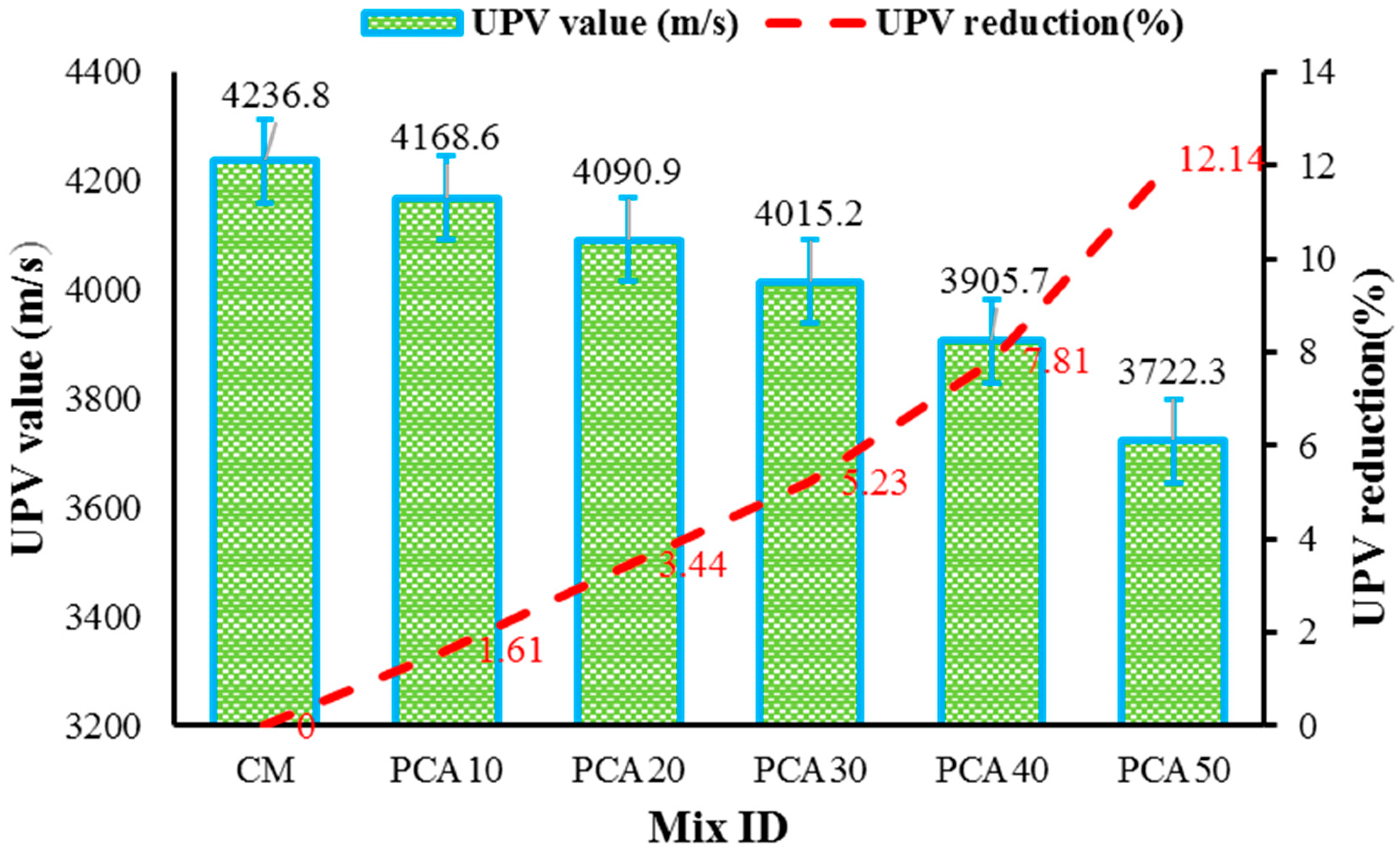
| Chemical Composition (Oxides) | Content (% Weight) | Physical Properties | Results |
|---|---|---|---|
| CaO | 63.58 | Specific gravity | 3.14(g·cm−3/g·cm−3) |
| SiO2 | 20.4 | Specific surface area | 321 (m2/kg) |
| Al2O3 | 5.10 | Consistency | 29.15% |
| FexOy | 4.10 | Initial setting time | 185 min |
| SO3 | 2.74 | Final setting time | 241 min |
| MgO | 2.56 | Fineness modulus | 93.30% |
| K2O | 0.88 | Compressive strength (28 days) | 46.56 (MPa) |
| Na2O | 0.23 | Soundness | 0.103% |
| Loss on ignition (LOI) | 0.41 | - | - |
| Property | NCA | PCA | Sand |
|---|---|---|---|
| Max. nominal size (mm) | 20 | 20 | 4.72 |
| Min. nominal size (mm) | 4.75 | 4.75 | 0.074 |
| SSD water Absorption (%) | 1.08 | 0 | 0.5 |
| Specific gravity | 2.71 | 1.21 | 2.78 |
| Color | Dark | Black brown | Dark |
| Shape | Angular | Angular | _ |
| Aggregate crushing value | 27.42 | 1.3 | NIL |
| Aggregate impact value (%) | 25.43 | 8.108 | NIL |
| Fineness modulus | NIL | NIL | 2.27 |
| Bulk density (g/cm3) | 1.51 | 0.49 | 1.60 |
| Mix ID | W/C | Cement | Water | Fine Aggregate | Coarse Aggregate | PCA |
|---|---|---|---|---|---|---|
| CM | 0.49 | 367.34 | 180 | 789.14 | 1133.32 | 0 |
| PCA10 | 0.49 | 367.34 | 180 | 789.14 | 1019.99 | 52.40 |
| PCA20 | 0.49 | 367.34 | 180 | 789.14 | 906.66 | 104.80 |
| PCA30 | 0.49 | 367.34 | 180 | 789.14 | 793.32 | 157.20 |
| PCA40 | 0.49 | 367.34 | 180 | 789.14 | 679.99 | 209.60 |
| PCA50 | 0.49 | 367.34 | 180 | 789.14 | 566.66 | 262.00 |
| Test Type | Standard Used | Mix ID | |||||
|---|---|---|---|---|---|---|---|
| 0% | 10% | 20% | 30% | 40% | 50% | ||
| Slump test | ASTM C143/C143M-20 | 3 | 3 | 3 | 3 | 3 | 3 |
| Fresh density | ASTM C138/C138M | 3 | 3 | 3 | 3 | 3 | 3 |
| Dry density | BS EN12390-7 | 3 | 3 | 3 | 3 | 3 | 3 |
| Compressive strength | ASTM C39/C39M | 3 | 3 | 3 | 3 | 3 | 3 |
| Split tensile strength | ASTM C496/C496M-17 | 3 | 3 | 3 | 3 | 3 | 3 |
| Flexural strength | ASTM C78/C78M-18 | 3 | 3 | 3 | 3 | 3 | 3 |
| Abrasion resistance | ASTM C131/C131-20 | 3 | 3 | 3 | 3 | 3 | 3 |
| Sorptivity coefficient | ASTM C1585-13 | 3 | 3 | 3 | 3 | 3 | 3 |
| UPV | ASTM C597-16 | 3 | 3 | 3 | 3 | 3 | 3 |
| Alternate wetting and drying | _ | 6 | 6 | 6 | 6 | 6 | 6 |
| Testing Type | Equipment’s Name | Manufacturer’s Country |
|---|---|---|
| Workability | Slump Cone | Turkish Exporter, Istanbol, Turkey |
| Fresh/dry density | Analytical balance | Pakistan |
| Compressive strength | Universal Testing Machine (UTM) | Japan |
| Split tensile strength | Universal Testing machine (UTM) | Japan |
| Flexural strength | Flexural testing machine | Japan |
| Sorptivity co-efficient | Cylinder (200 mm thickness & 100 mm dia) | Pakistan |
| Abrasion resistance | Los Angeles (LA) apparatus | Turkey |
| Ultrasonic pulse rate | PUNDIT/UPV Apparatus | Japan |
| Alternating wetting and drying (W–D) | 100 mm in side cubes tested using UTM | Pakistan |
| Mix ID | After 25 Cycles (MPa) | After 50 Cycles (MPa) | Loss of CS (%) | |
|---|---|---|---|---|
| After 25 Cycles | After 50 Cycles | |||
| CM | 33.3 | 28.2 | 19.2 | 31.6 |
| PCA10 | 33 | 31.4 | 11.1 | 15.4 |
| PCA20 | 29.8 | 28.4 | 8.31 | 12.6 |
| PCA30 | 25.81 | 24.2 | 6.86 | 12.6 |
| PCA40 | 21.35 | 20.2 | 6.73 | 11.8 |
| PCA50 | 18.38 | 17.7 | 5.74 | 9.23 |
Publisher’s Note: MDPI stays neutral with regard to jurisdictional claims in published maps and institutional affiliations. |
© 2021 by the authors. Licensee MDPI, Basel, Switzerland. This article is an open access article distributed under the terms and conditions of the Creative Commons Attribution (CC BY) license (https://creativecommons.org/licenses/by/4.0/).
Share and Cite
Ahmad, F.; Jamal, A.; Mazher, K.M.; Umer, W.; Iqbal, M. Performance Evaluation of Plastic Concrete Modified with E-Waste Plastic as a Partial Replacement of Coarse Aggregate. Materials 2022, 15, 175. https://doi.org/10.3390/ma15010175
Ahmad F, Jamal A, Mazher KM, Umer W, Iqbal M. Performance Evaluation of Plastic Concrete Modified with E-Waste Plastic as a Partial Replacement of Coarse Aggregate. Materials. 2022; 15(1):175. https://doi.org/10.3390/ma15010175
Chicago/Turabian StyleAhmad, Farhan, Arshad Jamal, Khwaja Mateen Mazher, Waleed Umer, and Mudassir Iqbal. 2022. "Performance Evaluation of Plastic Concrete Modified with E-Waste Plastic as a Partial Replacement of Coarse Aggregate" Materials 15, no. 1: 175. https://doi.org/10.3390/ma15010175






